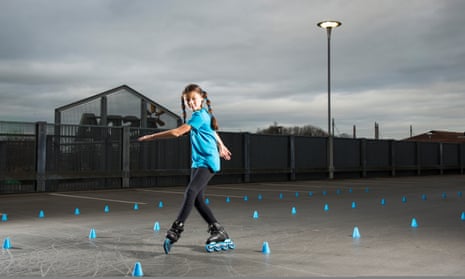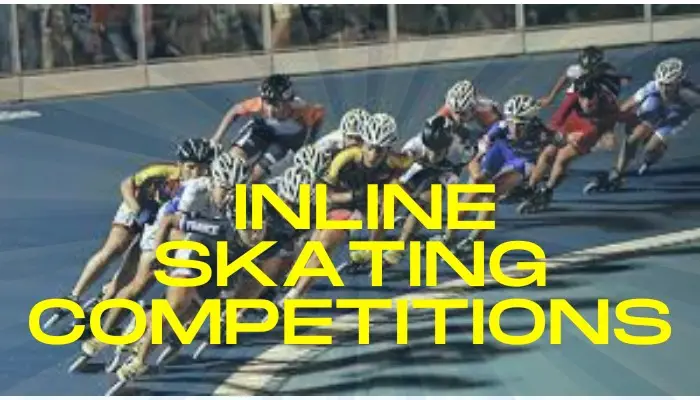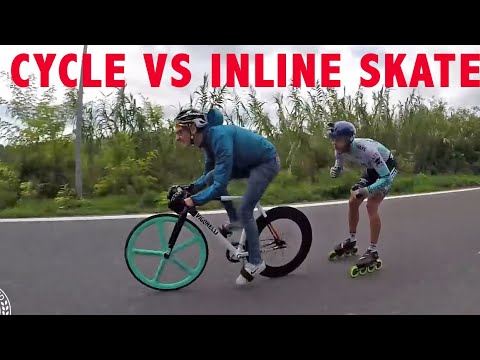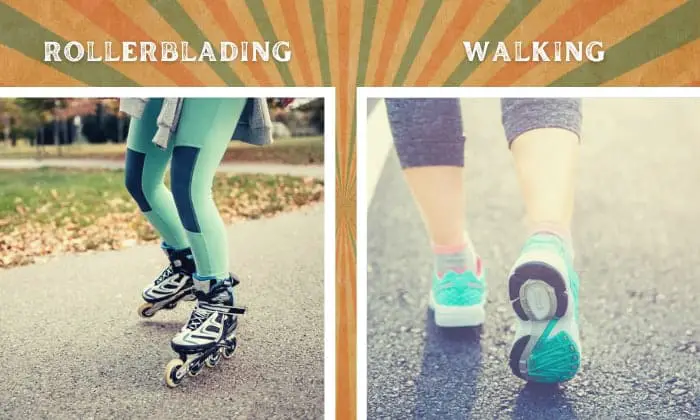How to Master Turning While Inline Skating: Top Techniques Revealed!
( If you purchase through our sponsored links, we may receive a small commission at no extra cost to you )
To turn while inline skating, shift your body weight towards the direction you want to go, and use your hips and legs to push off and steer the skates. This will help you change directions smoothly and safely.
Inline skating is a thrilling activity that allows you to glide effortlessly on wheels. Whether you’re a beginner or more experienced, being able to turn while inline skating is a crucial skill to master. By effectively turning, you can navigate corners, avoid obstacles, and enhance your overall control and agility on skates.
We will provide you with the essential tips and techniques to turn while inline skating. By following these guidelines and practicing regularly, you’ll be able to execute smooth and precise turns on your skates, adding more enjoyment and versatility to your inline skating experience. So, let’s jump right in and explore the wonderful world of turning while inline skating!
Understanding The Basic Techniques
Learn the essential techniques for turning while inline skating with ease. Discover the best tips and tricks to master the art of navigation on skates for a smoother and more enjoyable experience.
Understanding the Basic Techniques When it comes to inline skating, one of the most important skills to master is turning. Being able to turn effectively not only enhances your overall skating experience but also ensures a smooth and safe ride. In this section, we will delve into the basic techniques of turning while inline skating. By understanding proper body positioning, balancing techniques, and weight distribution, you’ll be on your way to becoming a more confident skater. Let’s get started!Proper Body Positioning
Maintaining the correct body position is crucial when it comes to executing turns while inline skating. By maintaining a proper posture, you’ll have better control and stability during your turns. Here’s what you need to focus on: 1. Keep your body aligned: Stand tall with your shoulders back and your eyes forward. Aligning your body properly will help you maintain balance and control throughout the turn. 2. Bend your knees: Keeping your knees slightly bent is essential for stability and maneuverability. This allows you to smoothly transition during turns and effectively absorb any bumps or obstacles you may encounter. 3. Engage your core: Your core muscles play a significant role in maintaining stability and balance. By engaging your core, you create a solid foundation for executing turns, making them more controlled and effortless.Balancing Techniques
Achieving and maintaining balance is a key component of successful turning while inline skating. These balancing techniques will help you stay centered and in control: 1. Find your center of gravity: Your center of gravity is the point where all your weight is evenly distributed. To turn effectively, make sure you have a solid understanding of where your center of gravity is located. This will allow you to shift your weight appropriately and execute smooth turns. 2. Learn to distribute your weight: As you initiate a turn, shift your weight slightly to the side you intend to turn towards. This redistribution of weight will help you carve the turn more effectively and maintain balance throughout the maneuver. 3. Practice balance exercises: Improving your balance through specific exercises can greatly enhance your turning ability. Exercises such as one-legged balances or practicing on uneven surfaces can help you develop the necessary stability and control required for turns.Weight Distribution
Understanding weight distribution is crucial for executing turns smoothly and efficiently. Here’s what you need to know: 1. Forward pressure: During your turns, it is essential to maintain a slight forward pressure to ensure control and stability. Leaning too far back can cause you to lose balance, while leaning too far forward can result in an uncontrolled turn. Find the right balance by shifting your weight forward just enough to maintain control. 2. Outside foot pressure: As you initiate a turn, apply slightly more pressure to the outside foot. This helps to create a better edge grip and allows you to carve the turn smoothly. By distributing your weight appropriately, you’ll achieve better control and fluidity throughout the turn. 3. Practice weight transfer: As you become more comfortable with turning, practice transferring your weight smoothly from one foot to the other. This will enable you to execute turns with ease and finesse, providing a more enjoyable skating experience. Remember, mastering the basic techniques of turning while inline skating is a gradual process. With consistent practice, proper body positioning, balancing techniques, and weight distribution will become second nature. Embrace the learning curve and enjoy the rewarding feeling of executing smooth and controlled turns on your inline skates. Happy skating!
Credit: www.theguardian.com
Mastering Turns On Inline Skates
When it comes to inline skating, mastering turns is an essential skill that can greatly enhance your overall skating experience. Whether you’re cruising down the street or tackling challenging terrain, being able to confidently maneuver and change direction is key. In this article, we will explore different techniques to help you become proficient in turning on inline skates.
Basic Turn Technique
Mastering the basic technique of turning on inline skates is the foundation for more advanced turns. This technique involves shifting your weight and using your edges to create a smooth and controlled turn.
Here are some steps to follow when executing a basic turn:
- Begin by assuming a comfortable stance with your knees slightly bent and your feet shoulder-width apart.
- Shift your weight onto the foot opposite the direction you want to turn. For example, if turning right, shift your weight onto your left foot.
- Lean slightly in the direction of the turn, using the edges of your skates to initiate the turn.
- Gradually increase the pressure on the edges as you execute the turn, maintaining balance and control.
- Complete the turn by straightening your body and shifting your weight back to the center.
Parallel Turn Technique
The parallel turn technique is a more advanced method of turning on inline skates, allowing for quicker and tighter turns. It involves the use of your upper body and core muscles to generate rotational force.
Here are the steps for executing a parallel turn:
- Assume a slightly wider stance than the basic turn technique, with your feet parallel to each other.
- Initiate the turn by rotating your shoulders and upper body in the direction you want to turn.
- Simultaneously, lean into the turn and use your edges to carve the turn.
- Engage your core muscles to generate rotational force and enhance the speed and efficiency of the turn.
- As you complete the turn, straighten your body and bring your feet back to a parallel position.
Power Slide Turn Technique
The power slide turn technique is a dynamic and advanced way to execute sharp turns while inline skating. It involves using your skates and body to create friction and slide sideways.
Here’s how to perform a power slide turn:
- Assume a low and balanced stance with your knees bent, ready to execute the power slide.
- Shift your weight onto your dominant leg and slightly lift the other leg off the ground.
- Simultaneously, turn your upper body and hips in the direction of the turn.
- Place your dominant foot perpendicular to your direction of travel, using the inside edge of your skate to create friction.
- Extend your sliding leg and use the outer edge of your skate to slide sideways, enabling a sharp turn.
- Complete the turn by bringing your feet back together and regaining your balance.
Mastering turns on inline skates takes practice and patience. By developing and honing these different turn techniques, you’ll become more confident and adept at navigating various skating environments. Remember to always prioritize safety and wear protective gear while practicing your turns.
Building Skills And Enhancing Turns
Inline skating is an exhilarating sport that requires finesse and control to perform smooth turns. By building the necessary skills and consistently practicing, you can enhance your turning capabilities and take your inline skating to the next level. In this section, we will explore three effective methods for improving your turns: practicing sharp turns, using obstacles for turns, and advanced turn training drills.
Practicing Sharp Turns
Sharpening your turning skills is essential for executing tight and precise turns while inline skating. By regularly practicing sharp turns, you can improve your balance, agility, and overall control. Here are some techniques to help you master this skill:
- Begin by performing gentle turns at a moderate speed. Focus on maintaining a low center of gravity, keeping your knees slightly bent, and shifting your body weight smoothly from one side to the other.
- As you become more comfortable, gradually increase your speed and challenge yourself with tighter turns. Concentrate on keeping your upper body facing the direction of the turn while pivoting your feet and lower body accordingly.
- Practice turning on different surfaces, such as concrete, asphalt, or even grass. This will enhance your adaptability and develop the necessary muscle memory for various turning conditions.
- Utilize visual markers, like cones or sidewalk cracks, to create a course for practicing sharp turns. Set them up at different distances and angles, challenging yourself to maneuver through the course with precision.
Using Obstacles For Turns
Another effective way to enhance your turning skills is by incorporating obstacles into your training routine. Obstacles not only add excitement to your skating sessions but also provide opportunities to refine your turning techniques. Consider the following tips:
- Identify suitable obstacles in your skating environment, such as poles, benches, or curbs.
- Approach the obstacle with controlled speed, ensuring you have enough space and time to execute the turn.
- Use the obstacle to your advantage by utilizing it as a pivot point. Plant your leading foot on the obstacle and pivot around it, executing a smooth and precise turn.
- Gradually increase the complexity of the obstacles to challenge your skills and improve your ability to adapt to different turning scenarios.
Advanced Turn Training Drills
If you’re looking to further enhance your turning skills, incorporating advanced turn training drills into your practice routine can be highly beneficial. These drills focus on improving your speed, agility, and overall control. Here are some examples:
- Figure 8 Drill: Set up two cones or markers in the shape of a figure 8. Practice weaving through the cones, emphasizing smooth transitions between turns.
- Crossover Drill: Begin by performing crossovers while moving in a straight line. Gradually introduce turns into the crossover motion, challenging yourself to maintain speed and stability.
- Slalom Drill: Set up a series of cones in a zigzag pattern. Weave through the cones, focusing on maintaining a consistent speed and executing quick, controlled turns.
- Jump Turn Drill: Incorporate small jumps into your turning practice. Jump and rotate your body mid-air, landing smoothly and continuing the turn.
By regularly practicing these advanced turn training drills, you’ll enhance your ability to maneuver with agility and precision while inline skating.

Credit: en.wikipedia.org

Credit: www.nytimes.com
Frequently Asked Questions On How To Turn While Inline Skating?
How Do You Turn When Inline Skating?
To turn when inline skating, shift your weight to the leg in the direction you want to go. Lean your body slightly in that direction and use your ankles and knees to guide your skates. Practice and maintain balance as you turn smoothly.
How Do You Skate While Turning?
To skate while turning, shift your weight towards the direction you want to turn. Bend your knees slightly and use your ankles to lean into the turn. Keep your eyes focused on where you want to go and use your edges to control your momentum.
Practice and maintain balance for smoother turns.
How Do You Rotate Inline Skates?
To rotate inline skates, shift your weight slightly to the foot that you want to rotate and push off with the other foot. Use your ankles and body motions to initiate the rotation and maintain balance. Practice and gradual improvement will help you master this technique.
How Do You Turn Around When Skating?
To turn around while skating, shift your weight on the foot opposite to the direction you want to go. Push off with that foot while keeping your other foot slightly raised. Use your arms for balance and momentum and practice turning gradually to improve your technique.
Conclusion
Learning how to turn while inline skating is a crucial skill that enhances control and maneuverability. By following the correct techniques, such as leaning in the desired direction and using your body weight to initiate the turn, you can confidently navigate corners and curves.
Remember to practice regularly and gradually increase your speed to master the art of turning while inline skating. So, get out there, stay safe, and enjoy the exhilarating experience of gliding and turning on your skates!






